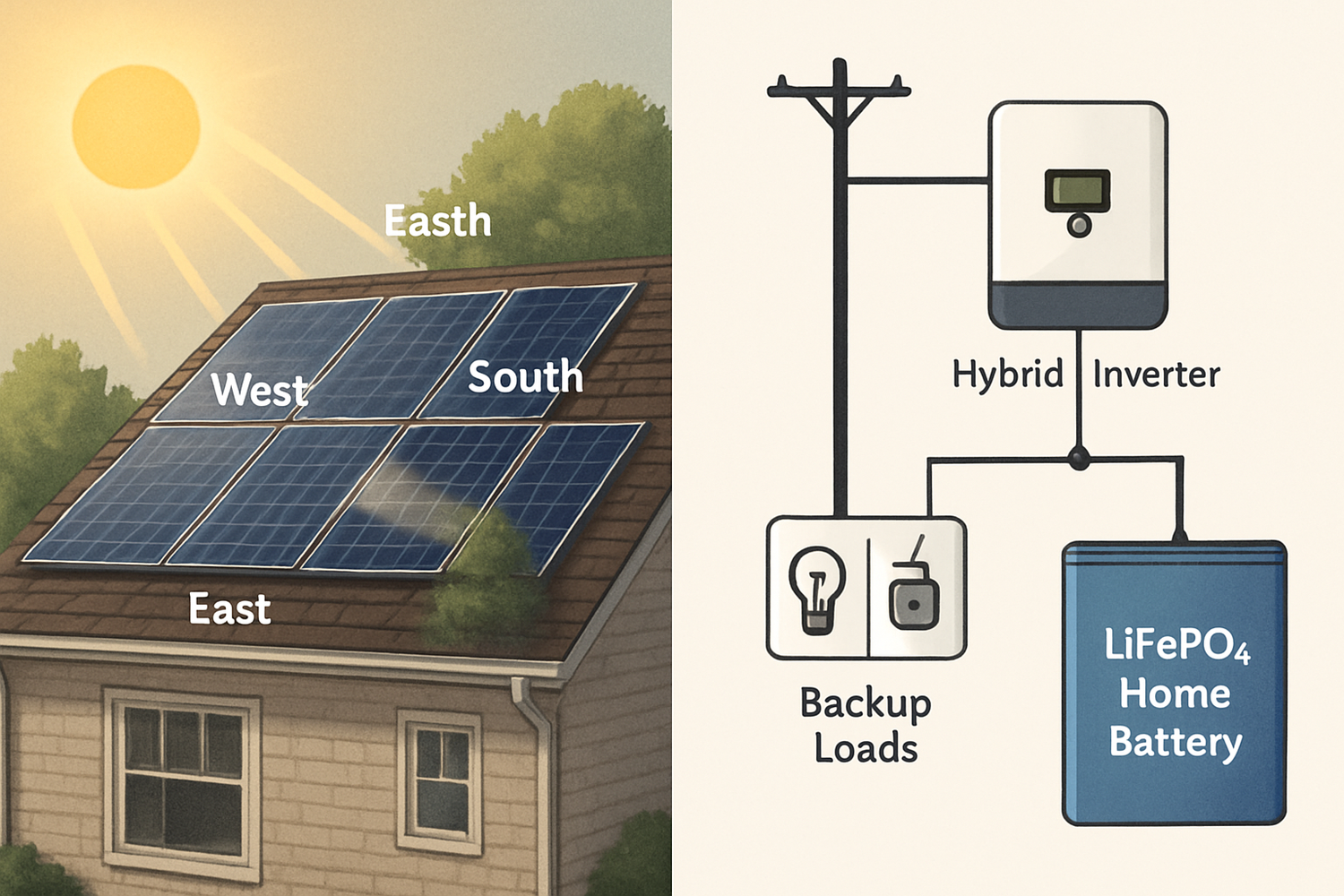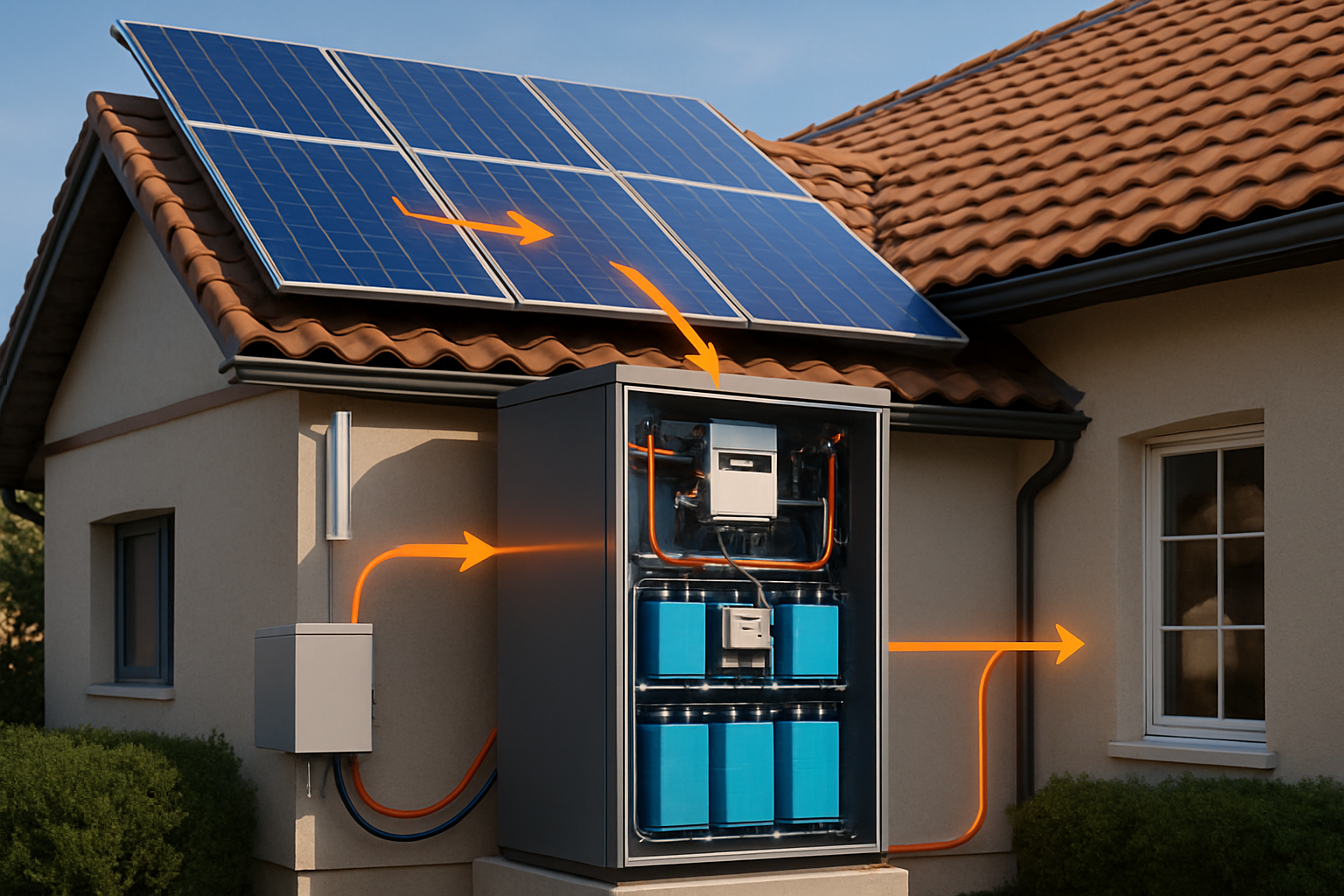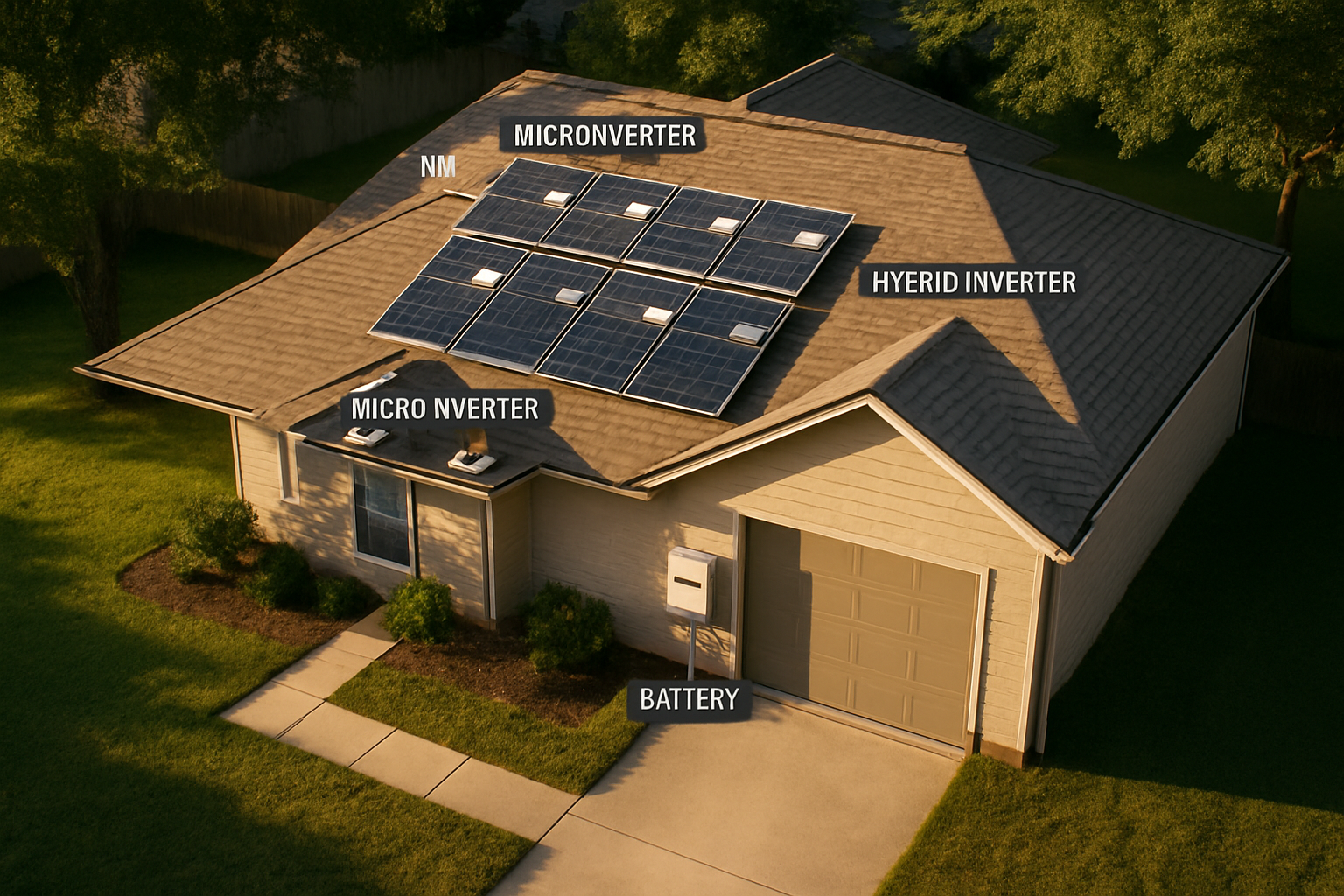Thinking, Is my home a good fit for solar? Many homeowners get stuck on the same solar energy misconceptions. Here are seven common solar myths and the facts you can use to make a confident decision. You will see practical checks for your roof, clear steps to cut solar panel installation barriers, and data from respected energy agencies.
Solar PV is highly modular and works from small rooftops to utility plants. That flexibility has been a core design feature for years, as noted in the IEA Technology Roadmap — Solar Photovoltaic Energy. Recent policy support and maturing supply chains also strengthen the case for homeowner solar, according to the IEA Energy Investment 2023 report and the U.S. DOE Solar Energy topic hub.

Myth 1: Only a perfectly south-facing roof works
This is a frequent Solar myth that pushes homeowners to wait. A south-facing roof at an optimal tilt can maximize annual yield, but it is not the only path. East- and west-facing arrays produce strong output, often close to a south array, especially during morning and late afternoon peaks. Module-level power electronics can further reduce mismatch and shade losses.
What to check at home
- Map your roof planes: south, east, west. Note pitch, size, and obstructions like vents.
- Run a shade analysis. Even simple app-based scans give useful first-pass insights.
- Ask for a design that splits arrays across suitable planes to smooth output.
PV’s modular nature supports creative layouts on complex roofs. That flexibility is highlighted in the IEA PV Roadmap, which shows PV deployed at small and large scales.
Myth 2: Solar doesn’t work in cold or cloudy climates
Solar energy misconceptions about climate are stubborn. PV cells convert light, not heat. Cool temperatures can improve cell efficiency, and many high-latitude regions see robust annual production. Output on cloudy days is lower, but annual energy still pencils out if the site has reasonable solar access.
What to check at home
- Look at annual, not just winter, irradiance. Your installer can pull satellite data.
- Confirm snow-shedding design and wind/snow load ratings that fit your code.
The U.S. DOE Solar Energy pages explain how modern modules and racking strategies address climate and weather concerns.
Myth 3: My roof is too old or complicated for solar
It’s smart to inspect the roof first. If the roof is near replacement, time both projects. Most residential PV adds about 2–3 pounds per square foot. That is within the capacity of many structures, but an engineering review is the right path for peace of mind. Complex roofs can use a mix of flush-mount and tilted racks.
What to check at home
- Get a roof condition report. If shingles are near end of life, bundle reroof + solar.
- Ask for structural calculations that reference local code loads.
- Consider electrical upgrades if your panel is undersized for a new backfed breaker.
Roof type and mounting snapshot
| Roof type | Typical mounting | Notes |
|---|---|---|
| Asphalt shingle | Flashed lag screws + rails | Most common, strong waterproofing with flashed penetrations |
| Metal standing seam | Clamp-on (no penetrations) | Fast install, minimal roof penetrations |
| Tile | Tile hooks or replacement mounts | Extra care for waterproofing; often higher labor |
| Flat roof | Ballasted or mechanically attached tilt racks | Ballast requires structural review; wind deflectors help |
PV’s ability to fit many roof types echoes the modular theme in the IEA PV Roadmap.
Myth 4: Solar is too expensive and prices are rising
Costs did rise in 2021–2022 for many clean energy technologies due to supply chain stress. Even so, policy support and manufacturing growth have helped steady the market. The IEA Energy Investment 2023 analysis notes that tax credits in the U.S. can reduce effective pricing for solar and storage. Global data from IRENA also show strong long-run declines in PV module prices and delivered energy costs over the past decade.
What to check at home
- Ask for total cost of ownership. Include incentives, expected output, and maintenance.
- Compare financing options: cash, loans, or other products from local lenders.
- Consider future electricity rate risk. PV can hedge part of your bill.
New policies can boost affordability. The IEA report highlights extended U.S. investment tax credits for PV and a credit for standalone battery storage under recent legislation, plus EU measures to speed clean power deployment and funding for grids. See IEA Energy Investment 2023 for the policy snapshot.
Myth 5: Permitting and paperwork will stall my project for ages
Permitting has been a real barrier in many regions. Queues for approvals are sizable in the U.S. and several European markets, as the IEA investment analysis documents. That said, many jurisdictions now offer fast-track residential solar permits, template interconnection forms, and online portals that cut wait times.
What to check at home
- Ask your installer for a clear permitting timeline. Identify the utility’s review steps.
- Use standardized design packages to avoid resubmittals.
- Plan for meter swaps and inspection schedules at the proposal stage.
Context from the IEA investment analysis shows that practical obstacles, including permitting, are a focus area for policymakers. Expect continued process improvements.
Myth 6: Solar keeps my lights on in an outage by itself
Most grid-tied systems shut down during outages to protect line workers. You need a hybrid inverter plus a battery to power backup loads. A resilient setup isolates critical circuits and uses stored energy at night or during storms. LiFePO4 home batteries are a strong fit thanks to their stability, long cycle life, and high efficiency.
What to check at home
- List critical loads: fridge, lights, outlets, internet, medical devices.
- Size storage for hours of autonomy you need, then add PV to recharge.
- Confirm your hybrid inverter supports islanding and rapid shutdown as required by code.
Simple backup sizing example
| Load | Typical power (W) | Daily energy (kWh) |
|---|---|---|
| Refrigerator | 150 | 1.5 |
| LED lights (6 rooms) | 100 | 0.5 |
| Wi‑Fi + laptop/phone charging | 70 | 0.7 |
| Misc. outlets (low duty) | 100 | 1.0 |
| Total | — | 3.7 kWh/day |
A 10 kWh LiFePO4 battery could cover these basics for roughly two nights with daytime PV recharge, with margin. Your actual use will vary.
Tax credits now support battery storage in the U.S., which the IEA Energy Investment 2023 assessment notes. The DOE Solar Energy hub offers additional basics on PV and storage.
Myth 7: Solar panels damage roofs and batteries are unsafe
Properly installed systems use flashed or clamp-on mounts that maintain waterproofing. Installers follow building and electrical codes, including rapid-shutdown and fire-setback rules. For storage, LiFePO4 chemistry is known for thermal stability and is widely used in home energy systems. Equipment carries safety listings and must pass inspections.
What to check at home
- Ask for UL-listed modules, inverters, and batteries; confirm local code compliance.
- Request details on flashing, sealants, and penetrations in the roof plan.
- Verify battery placement meets clearance and ventilation guidelines.
Clean energy deployment growth has come with stronger standards and oversight. Policy support and manufacturing scale are detailed across regions in the IEA investment report, while IRENA tracks global technology trends and costs.
Practical checklist: Is my home suitable for solar?
- Roof condition: at least 10–15 years of life left or plan a reroof bundle.
- Shading: less than 10–20% annual shade on planned array area is a good target.
- Electrical: service panel has capacity for a backfeed breaker or uses a line-side tap.
- Loads and goals: set targets—bill offset, backup power, or both.
- Local rules: confirm permitting steps and interconnection timelines early.
PV can serve grid-tied homes, cabins, and farms. For remote sites, off-grid solar with LiFePO4 storage and an inverter/charger can provide reliable power. These architectures reflect PV’s modular and scalable design highlighted by the IEA PV Roadmap.
Key data points that cut through the noise
- PV is modular. It fits rooftops and mini-grids as noted by the IEA PV Roadmap.
- Cost trends: Long-run module and PV energy costs fell sharply, per IRENA. Short-term bumps occurred in 2022, but policy support offsets some impacts, says the IEA energy investment analysis.
- Policy tailwinds: U.S. incentives include tax credits for PV and standalone batteries, and Europe is fast-tracking permits and funding grids, per IEA 2023.
- Permitting: Backlogs exist, yet many regions are streamlining residential approvals. See the context in the IEA 2023 assessment and process basics on the DOE Solar Energy hub.
What this means for your decision
You do not need a perfect roof, a desert climate, or a massive budget to benefit from solar. A careful site review, clean design, and a plan for backup loads where needed will get you most of the way there. If you want energy independence, a home storage system using LiFePO4 batteries and a hybrid inverter can bridge outages and shift solar energy into the evening.
As energy agencies note, PV is scalable, maturing fast, and backed by stronger policies. Start with a roof check and a data-driven proposal. That moves the conversation from Solar myths to measurable results.
Disclaimer: Policy and incentive references are informational only and may change. This content is not legal or tax advice. Consult qualified professionals for your location.





Leave a comment
All comments are moderated before being published.
This site is protected by hCaptcha and the hCaptcha Privacy Policy and Terms of Service apply.